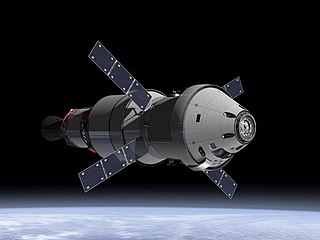Related Research Articles
COMSAT, Inc. is a leading operator of customized, secure end-to-end satellite communications services. COMSAT delivers a full portfolio of fixed satellite solutions, mobile satellite solutions, and teleport services to aeronautical, land-mobile, and maritime users in multiple markets, including U.S. government and military, global governments and commercial maritime. COMSAT is wholly owned by Satcom Direct (SD). SD offers global communications services, support, and technology to business and general aviation, military, government, emergency response, media, and others who depend on reliable, global communications. SD supports customers via locations around the globe including our world headquarters and network operations center (NOC) located in Melbourne, Florida.

Inmarsat plc is a British satellite telecommunications company, offering global mobile services. It provides telephone and data services to users worldwide, via portable or mobile terminals which communicate with ground stations through thirteen geostationary telecommunications satellites. Inmarsat's network provides communications services to a range of governments, aid agencies, media outlets and businesses with a need to communicate in remote regions or where there is no reliable terrestrial network. The company was listed on the London Stock Exchange until it was acquired by Connect Bidco, a consortium consisting of Apax Partners, Warburg Pincus, the CPP Investment Board and the Ontario Teachers' Pension Plan, in December 2019.
COMSAT Mobile Communications (CMC), a telecommunications company which provides global mobile communications solutions to the maritime, land mobile and aeronautical communities, and offers data, voice, fax, telex and video capabilities via the Inmarsat geosynchronous satellite constellation through two earth station facilities in Southbury, Connecticut, and Santa Paula, California. CMC was a business unit of COMSAT Corporation of Bethesda, MD (delisted).
Marisat satellites were the first maritime telecommunications satellites and were designed to provide dependable telecommunications for commercial shipping and the U.S. Navy from stable geosynchronous orbital locations over the three major ocean regions. The three Marisat satellites, F1, F2, and F3, were built by Hughes Aircraft Corporation (HAC) for COMSAT Corporation starting in 1973. The satellites were designed to provide maritime telecommunications services in three large ocean areas, the Atlantic Ocean, the Pacific Ocean, and the Indian Ocean, and were located at 72.5° East longitude, 176.5° E, and 345° E in the geosynchronous orbital arc. The three-satellite Marisat system served as the initial INMARSAT constellation.

TDRS-1, known before launch as TDRS-A, was an American communications satellite which was operated by NASA as part of the Tracking and Data Relay Satellite System. It was constructed by TRW and launched by Space ShuttleChallenger on its maiden flight, STS-6.
Intelsat IV F-7 was a geostationary communication satellite built by Hughes, it was owned by Intelsat. The satellite was based on the HS-312 platform and its estimated useful life was seven years.
Intelsat 505, previously named Intelsat V F-5, was a communications satellite operated by Intelsat. Launched in 1982, it was the fiveth of fifteen Intelsat V satellites to be launched. The Intelsat V series was constructed by Ford Aerospace, based on the Intelsat-V satellite bus.
Intelsat 506, previously named Intelsat V F-6, was a communications satellite operated by Intelsat. Launched in 1983, it was the sixth of fifteen Intelsat V satellites to be launched. The Intelsat V series was constructed by Ford Aerospace, based on the Intelsat-V satellite bus.
Intelsat 508, previously named Intelsat V F-8, was a communications satellite operated by Intelsat. Launched in 1984, it was the eighth of fifteen Intelsat V satellites to be launched. The Intelsat V series was constructed by Ford Aerospace, based on the Intelsat-V satellite bus. Intelsat V F-8 was part of an advanced series of satellites designed to provide greater telecommunications capacity for Intelsat's global network.
Intelsat 509, previously named Intelsat V F-9, was a communications satellite operated by Intelsat. Launched in 1984, it was the ninth of fifteen Intelsat V satellites to be launched. The Intelsat V series was constructed by Ford Aerospace, based on the Intelsat-V satellite bus. Intelsat V F-9 was part of an advanced series of satellites designed to provide greater telecommunications capacity for Intelsat's global network. He also carried a Maritime Communications Services (MCS) package for Inmarsat. However, the launch vehicle failed to put the satellite into a useful orbit.
Intelsat 510, previously named Intelsat VA F-10, was a communications satellite operated by Intelsat. Launched in 1985, it was the tenth of fifteen Intelsat V satellites to be launched. The Intelsat V series was constructed by Ford Aerospace, based on the Intelsat-V satellite bus. Intelsat V F-10 was part of an advanced series of satellites designed to provide greater telecommunications capacity for Intelsat's global network.
Intelsat 511, previously named Intelsat VA F-11, was a communications satellite operated by Intelsat. Launched in 1985, it was the eleventh of fifteen Intelsat V satellites to be launched. The Intelsat V series was constructed by Ford Aerospace, based on the Intelsat-V satellite bus.
Intelsat 512, previously named Intelsat VA F-12, was a communications satellite operated by Intelsat. Launched in 1985, it was the twelfth of fifteen Intelsat V satellites to be launched. The Intelsat V series was constructed by Ford Aerospace, based on the Intelsat-V satellite bus.
NSS-513, previously named Intelsat VA F-13 or Intelsat 513, was a communications satellite operated by Intelsat and which was later sold to New Satellite Skies on November 30, 1998. Launched in 1988, it was the thirteenth of fifteen Intelsat V satellites to be launched. The Intelsat V series was constructed by Ford Aerospace, based on the Intelsat-V satellite bus.
Intelsat 514, previously named Intelsat VA F-14, was a communications satellite operated by Intelsat. Launched in 1986, it was the fourteenth of fifteen Intelsat V satellites to be launched. The Intelsat V series was constructed by Ford Aerospace, based on the Intelsat-V satellite bus.
Columbia 515, previously named Intelsat VA F-15 or Intelsat 515, was a communications satellite operated by Intelsat and which was later sold to Columbia Communications Corporation. Launched in 1989, it was the fifteenth of fifteen Intelsat V satellites to be launched. The Intelsat V series was constructed by Ford Aerospace, based on the Intelsat-V satellite bus.
Intelsat 907 is a communications satellite operated by Intelsat.
Marisat 2 is a communications satellite operated by COMSAT. Marisat 2 was the second of a series of COMSAT maritime communications satellites.
Marisat 3 is a communications satellite operated by COMSAT. Marisat 3 was the second of a series of COMSAT maritime communications satellites.

This article documents expected notable spaceflight events during the year 2022.
References
- ↑ Krebs, Gunter. "Marisat 1, 2, 3". Gunter's Space Page. Retrieved May 23, 2017.
- ↑ McDowell, Jonathan. "Launch Log". Jonathan's Space Page. Retrieved May 23, 2017.
- 1 2 3 4 5 6 7 "Marisat 1". NSSDC Master Catalog. Retrieved May 23, 2017.

| This article about one or more spacecraft of the United States is a stub. You can help Wikipedia by expanding it. |